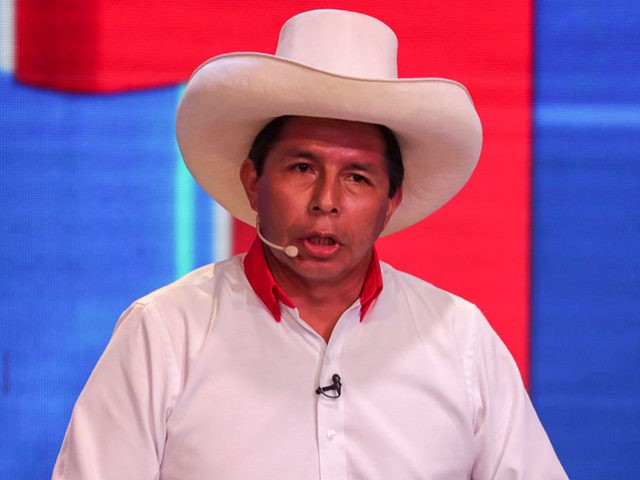Recently inaugurated communist President Pedro Castillo is seeking to expand political and trade ties to China, Reuters reported on Friday, with little room to grow given China’s status as Peru’s largest trade partner already and Peru’s participation in the Belt and Road Initiative (BRI).
Peruvian electoral authorities took over a month to certify Castillo’s win in the June 6 presidential election against conservative contender Keiko Fujimori due to an extremely close vote count and evidence of voter fraud. Fujimori contested about 500,000 ballots, claiming evidence indicated their were invalid and should not count, representing significantly more than the about 40,000 votes that Castillo won the election with. Peru’s National Jury of Elections (JNE) ultimately rejected Fujimori’s evidence.
Castillo’s election has proven significantly controversial in the country given his extreme leftist political party Free Peru’s ideological slant. The official manifesto of the party praises Russian communist Vladimir Lenin and Cuban dictator Fidel Castro; Castillo himself vowed to rewrite the nation’s constitution if elected. Castillo has repeatedly denied being a communist personally but has not disavowed the content of his political party’s platform.
Castillo’s attempts to bring Peru deeper into China’s orbit are not a significant departure from prior Peruvian government policy, but notable in that Castillo is a closer ideology ally to China than his predecessors, who sought Chinese economic investment without openly embracing communism.
“Since Castillo was inaugurated on July 28, administration officials have met with the Chinese ambassador and Chinese mining executives to discuss not just policies for their industry but also to strengthen a previous free trade agreement first signed in 2009,” Reuters reported on Friday, citing unnamed government sources. The news agency described Peru’s prodigious mining industry as a priority for Beijing.
Reuters also noted that Castillo is using his cabinet to maintain close communications with Chinese envoys in the country, sending his Foreign Trade and Tourism Minister Roberto Sánchez to meet with Chinese Ambassador Liang Yu on Monday. Other reports confirming the meeting noted that, in addition to discussing expansion of an already existing free trade agreement, Sánchez sought to come up with ways to increase Chinese tourism to Peru. Home to some of the world’s most popular ancient historical sites like the Incan former city of Macchu Picchu, Peru heavily relies on tourism to bolster its economy and has, thus, suffered significantly following the eruption of the Chinese coronavirus pandemic in late 2019.
Even prior to his formal recognition as the next president of Peru, Castillo made public that he considered Lima’s relationship with Beijing of utmost importance. Castillo made time for a visit with Yu at the Chinese embassy in Lima on July 15, publishing photos of himself with the ambassador on social media.
Castillo described the meeting as an attempt to “prioritize the ties of brotherhood and cooperation between both nations.”
Nos reunimos con Liang Yu, embajador de la República Popular China en Perú (@ChinaEmbPeru), para priorizar los lazos de hermandad y cooperación entre ambos países. #SeguimosAvanzando pic.twitter.com/hDAzEbGU0M
— Pedro Castillo Terrones (@PedroCastilloTe) July 15, 2021
In a feature on Peru-China ties published in July, Chinese state media outlet CGTN noted that China is Peru’s largest trade partner and has been since 2014, four years after the free trade agreement. It is one of Peru’s most important purchasers of copper and ore – arguably Peru’s largest industry – and a key economic partner following the signing of the 2010 free trade agreement under then-neo-liberal President Alan García. García served as a far-left president in the 1980s before reinventing himself and committed suicide in April 2019 after being accused of extensive corruption.
Peru joined the Belt and Road Initiative in 2019 under President Martín Vizcarra, whose ouster last year led to Peru having three presidents within the span of half a year. China has touted the BRI as a global infrastructure plan meant to recreate the Ancient Silk Road, which connected eastern China to Western Europe thousands of years ago. No historical evidence suggests that Peru or any of the Western Hemisphere were part of the Ancient Silk Road.
BRI projects typically consist of China offering poorer countries predatory loans intended to be used to pay Chinese companies to build ports, roads, and railways. Beijing typically sells the projects by claiming they will make up their value in revenue. In reality, the countries that have participated in the program have seen themselves in dangerous levels of debt and, in some cases, forced to forfeit the properties to China.
The Chinese coronavirus pandemic has also made Peru more reliant of China, particularly for its vaccine supply. Peru has endured one of the worst national outbreaks of the disease, resulting in nearly 200,ooo deaths since the pandemic began. Peru has documented over 2.1 million coronavirus cases as of Friday.
“The issue of vaccines was discussed, we want to ensure the rapid supply of vaccines because it is important for the health system and also for the country’s economy,” Castillo’s then-economic advisor Pedro Francke told Reuters in mid-June, referring to a discussion during Castillo’s visit to the Chinese embassy. Peru is currently using the Chinese-made Sinopharm vaccine candidate for coronavirus inoculation.
Follow Frances Martel on Facebook and Twitter.

COMMENTS
Please let us know if you're having issues with commenting.